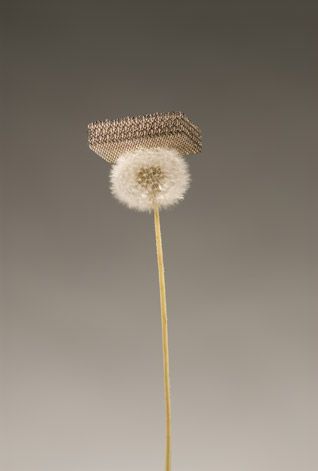ScienceDaily reports that, “A team of researchers from UC Irvine, HRL Laboratories and the California Institute of Technology have developed the world’s lightest material — with a density of 0.9 mg/cc — about one hundred times lighter than Styrofoam™.”
Their findings appear in the Nov. 18 issue of Science.
Looking a bit like a jacks matrix, this “micro-lattice” cellular architecture consists of 99.99 percent air and a lattice of interconnected hollow tubes with a wall thickness 1,000 times thinner than a human hair, according to Dr. Tobias Schaedler of HRL.
Despite its extreme lightness, the advanced material is not flimsy. Squeezing it to 50 percent of its original dimensions does not destroy the lattice. Instead, it handles the high strain and resumes its original size and shape, the ultimate memory metal. Energy absorption capabilities are also high,
as are its possibilities for use in “battery electrodes and acoustic, vibration or shock energy absorption,” according to Science Daily.
The new material was developed for the Defense Advanced Research Projects Agency (DARPA), according to Science Daily. The report quotes William Carter, manager of the architected materials group at HRL. “Modern buildings, exemplified by the Eiffel Tower or the Golden Gate Bridge, are incredibly light and weight-efficient by virtue of their architecture. We are revolutionizing lightweight materials by bringing this concept to the nano and micro scales.”
“Materials actually get stronger as the dimensions are reduced to the nanoscale,” explained UCI mechanical and aerospace engineer Lorenzo Valdevit, UCI’s principal investigator on the project. “Combine this with the possibility of tailoring the architecture of the micro-lattice and you have a unique cellular material.”
The team’s abstract for their findings can be found at the Science web site.
“Ultralight (<10 milligrams per cubic centimeter) cellular materials are desirable for thermal insulation; battery electrodes; catalyst supports; and
acoustic, vibration, or shock energy damping. We present ultralight materials based on periodic hollow-tube microlattices. These materials are fabricated by starting with a template formed by self-propagating photopolymer waveguide prototyping, coating the template by electroless nickel plating, and subsequently etching away the template. The resulting metallic microlattices exhibit densities ρ ≥ 0.9 milligram per cubic centimeter, complete recovery after compression exceeding 50% strain, and energy absorption similar to elastomers. Young’s modulus E scales with density as E ~ ρ2, in contrast to the E ~ ρ3 scaling observed for ultralight aerogels and carbon nanotube foams with stochastic architecture. We attribute these properties to structural hierarchy at the nanometer, micrometer, and millimeter scales.”


Comments 1
VERY IMPRESSIVE!